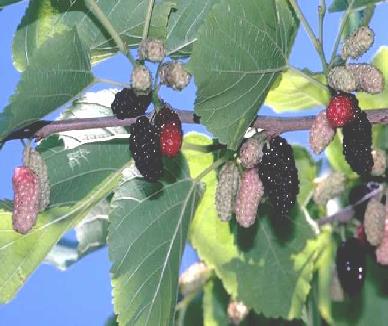
Morus nigra / توت
Toot, Firssad, Toot Shami
Black Mullberry, Moral
Firssad, Toot
Moraceae
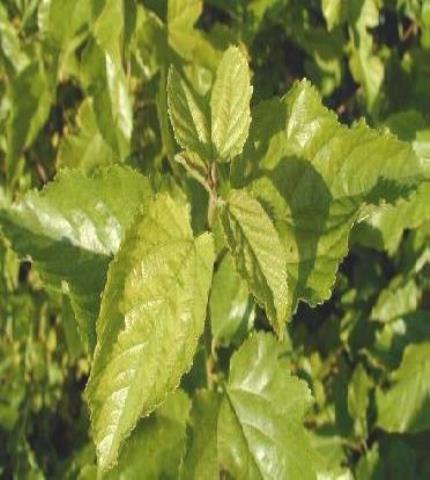
Leaves
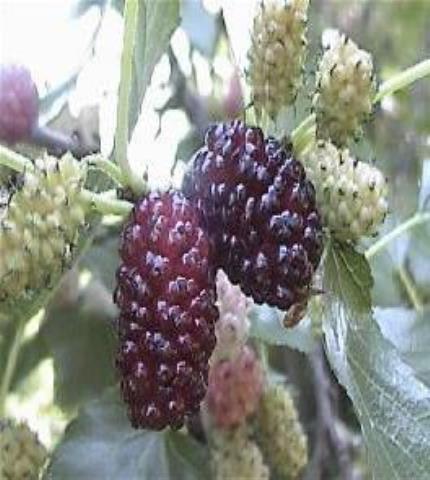
Fruits
Ethnobotanical Characteristics
Description
Deciduous tree, slow growing , up to15m high, much branched stems, dull green orange tinged to dark grey stem bark, have an attractive appearance. Leaves simple, alternate, thick, rough, dark green, broadly ovate, petiolate, sometimes irregularly lobed, 2-3 lobes, 6-12x6-12 cm, shortly acuminate, serrate, base cordate, scabrous above, pubescent beneath. Flowers in axillary unisexual spikes, dioecious either on the same tree or different trees, the female flowers are borne in erect, cylindrical short capitate spikes, perianth 4, stigmas 2, perianth and styles covered with long soft hairs; male flowers in catkin – like spikes 1.5-3cm long, perianth segments 4 fused at base, stamens 4. Fruits false compound, fleshy deep red drupes, 2-8.5 cm long, cylindrical or ovoid, sweet and edible.
Habitat & Distribution
The genus Morus has seven species of deciduous trees mainly in temperate regions now naturalized in tropical & subtropical regions; occurring in North & South America, Africa and Asia. M. nigra is native to Iran and far east, cultivated extensively all around the world for centuries, in UAE two species M. nigra and M. alba widely cultivated.
Part(s) Used
Leaves, fruits, bark
Traditional & Medicinal Uses
Fruit is nutritive, cooling, mild laxative, expectorant; and used in food manufacturing. The bark is astringent, purgative and vermifuge and anthelimintic. Leaves are used as gargle in cases of inflammation of vocal cords and as antidiabetic. Fruits used in sore throat melancholia ,dyspepsia and allays thirst and fever. In Indian a paste from the leaves mixed with another herb is used for bed sores; and also eaten by cattle. The Greeks used the plant to treat gout and named the fruit as “gout fruit”. The plant also used traditionally to treat hemorrhoids, diarrhea, burns, gingivitis, kidney stones, impotency, dysentery, wounds, emmenagogue and as antimicrobial.
Pharmacognosy and Phytochemistry
Parts studied
Leaves
Microscopical Description
A transverse section of the leaf shows a unilateral structure. The upper epidermis is covered with a thick striated cuticle. The epidermal cells are colourless, anticlinal mostly oblong but round cells also exist. Some epidermal cells also extend to form papillose cells or short covering trichomes. Few longer conical trichomes are also observed. The mesophyll palisade tissue consists of one layer of oblong compactly arranged cells with straight cell walls. They are smaller in size compared to the upper epidermal cells and they are rich in chlorophyll and some small-sized coloured crystalline substances. The spongy mesophyll cells are small, round or oblong compactly held cells. Some of those cells adjacent to the palisade cells contain large rosettes of calcium oxalate crystals. The other cells contain coloured materials, large brown crystalline substances and prisms. The mesophyll spongy cells are traversed by vascular strands containing spirally thickened vessels. The lower epidermal cells are small oval periclinal cells covered with a thick striated cuticle. Unicellular conical covering trichomes a are more observed on the lower epidermis with their round basal cells. Also, clavate glandular trichomes are observed on the lower epidermis. Stomata are oval, anomocytic and they are well-distributed on both epidermises (DPS, ZCHRTM unpublished results).
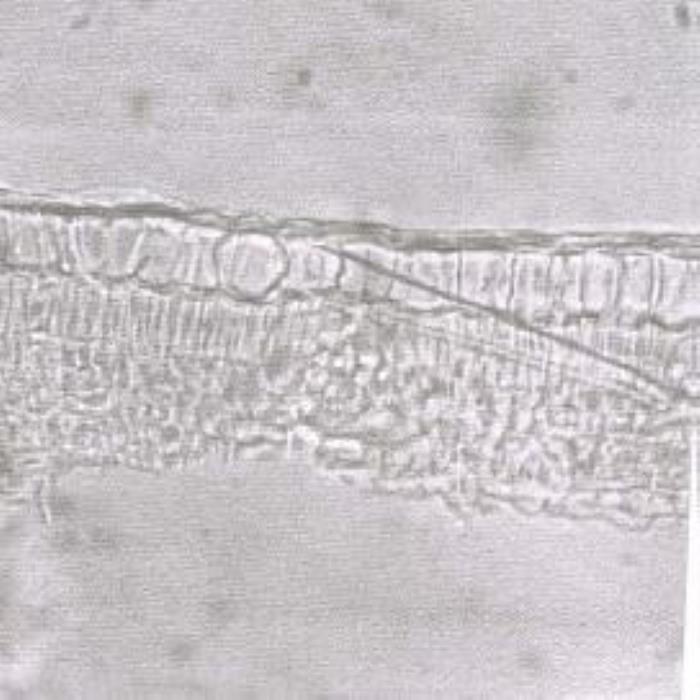
a) TS of leaf

b) Upper epidermis
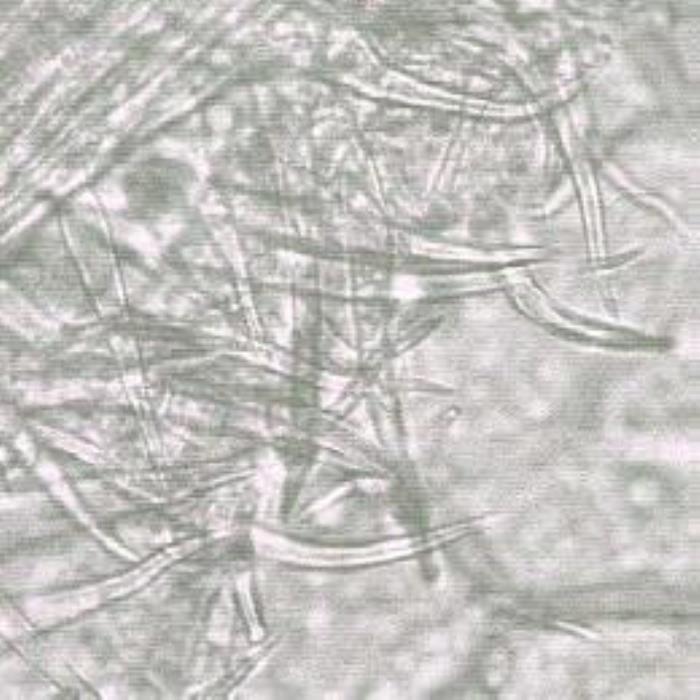
c) Lower epidermis
- (a). TS of a portion of the leaf showing the unilateral structure of the leaf, the thick striated cuticle that covers the anticlinal oblong upper epidermal cells, one layer of palisade tissues, small rounded to oblong mesophyll spongy cells and small oval periclinal lower epidermal cells. Shown also is a long tapering covering trichome.
- (b). Surface view of the upper epidermis showing some papillose epidermal cells circular in outline and typical polygonal epidermal cells.
- (c). Surface view of the lower epidermis of the leaf showing dense conical, tapering or a little curved covering trichomes on the epidermis near to a main vein (Magnification: x 400, x 250 and x 250, respectively).
Organoleptic characteristics
Appearance: Powder
Colour: Green
Odour: Aromatic
Taste: Tasteless
Physicochemical constants
Loss in weight on drying at 105°c (%): 8.00-8.20
Solubilities (%)
Alcohol solubility: 8.80-9.60
Water solubility: 28.80-29.60
70% ethanolic extractive: 34.00
Ash values (%)
Total ash: 16.80-17.00
Water soluble ash: 2.60-2.80
Acid-insoluble ash: 4.80-5.20
Successive extractive (%)
Petroleum ether (60-8°c): 4.60
Chloroform: 3.00
Absolute alcohol: 9.40
Distilled water: Not done
pH values
pH of 1% solution: 8.13
pH of 10% solution: 8.36
The above results are under process of publication (DPS, ZCHRTM) Chemical constituents: Flavonoids specially rutin. (DPS, ZCHRTM unpublished results).
Pharmacological and Toxicological studies
The antioxidant effect of three different extract of Morus nigra (Mulberry) fruit has been shown a protective action against peroxidative damage to biomembranes and biomolecules (Naderi et al. 2004). The plant extract at the dose of 20 mg/kg body mass produced a significant increase in the catalytic concentration of glutathione in the live of diabetic mice with a decrease in MDA concentration, showed antihyperglycemic activity (Petlevski et al. 2003 a&b). Antinociceptive properties of prenylflavonoid isolated from Morus nigra root bark has been investigated in classical models of pain in mice showed that the plant exhibits a promising antinociceptive or analgesic activity, being more than some standard drugs used as reference (De Souza et al. 2000). Morus nigra has also been reported for in the treatment of renal stones (Efraim & Eran 2002). Recently the Morus nigra has been reported to reduce hypersensitivity reactions (Caiaffa et al. 2003).
The pharmacological and toxicological studies carried out in our laboratory and the results in brief, on Moris alba (70% ethanolic extract) have been given below:
The results presented without references showed unpublished data (unpublished, ZCHRTM, DBMS):
1.) Ethanolic Extract 70%
|
ACTIVITY |
RESULTS |
|
Effect on GIT smooth Muscle-Isolated rabbit jejunum |
Produced mild increase in amplitude. |
|
Effect on GIT smooth Muscle-Isolated rat fundus |
Produced very significant contraction. |
|
Gross behavioral studies -Tremor/Twitches |
No toxic effect observed. |
|
Gross behavioral studies –Writhing |
No Writhing observed. |
|
Gross behavioral studies -Diarrhea, Urination |
No diarrhea observed. |
|
Mortality |
No death recorded. |
|
Motor co-ordination (String &Platform test) |
Motor co-ordination not affected. |
|
Acute toxicity studies |
No toxic signs and symptoms observed. |
|
LD50 evaluation |
> 10 g/kg. |
Summary of the results
The plant produced significant contraction with high amplitude and low frequency of contraction could be studied further as anti-vomiting agent The extract showed no overt signs and symptoms at the high dose level administered orally (10 g/kg, p.o.).
2.) Aqueous Extract
|
ACTIVITY |
RESULTS |
|
Anti-inflammatory activity |
The extract showed significant anti-inflammatory activity using Cotton Pellet method. |
|
Cardiotonic activity & HR-Isolated rat atria |
Increased force of contraction. |
|
Effect on GIT smooth Muscle-Isolated rabbit jejunum |
Produced mild reduction in amplitude of contraction. |
|
Effect on GIT smooth Muscle-Isolated rat fundus |
No contractile effect. |
|
Gross behavioral studies -Tremor/Twitches |
No tremors observed. |
|
Gross behavioral studies –Writhing |
No writhing observed. |
|
Gross behavioral studies - Diarrhea, Urination |
No diarrhea observed. |
|
Mortality |
No death reported. |
|
Motor co-ordination (String &Platform test) |
Motor co-ordination not affected. |
|
Acute toxicity studies- |
No toxic effect or death recorded. |
|
LD50 evaluation |
>10 g/kg. |
Summary of the results
The plant extract showed anti-inflammatory activity on sub-acute treatment in the rats. The extract showed no overt signs and symptoms at the high dose level administered orally (10 g/kg, p.o.).
References
- Andrews, F.W. The Flowering Plants of Anglo-Egyptian Sudan; (1950&1952) vol 1+II; Arbroath, Scotland.
- Bown, D. (1995) Encyclopedia of Herbs & Their Uses. Dorling Kindersley Limited, London. ISBN 0-7513-020-31.
- Caiaffa,M.F.,Cataldo,V.M. Tursia & Macchia,L.(2003). Fig & Mulberry cross allergy. Ann Allergy Asthma Immunol 91950:493-5.
- Chevallier, A. The Encyclopedia of Medicinal Plants. (1996) Dorling Kindersley Limited, London. ISBN 0 7513 03143.
- Baurin N, Arnoult E, Scior T, Do QT, Bernard P., (2002) Preliminary screening of some tropical plants for anti-tyrosinase activity. J Ethnopharmacol. 82(2-3): 155-8.
- Cao Y, Chu Q, Ye J., (2003) Determination of hydroxyl radical by capillary electrophoresis and studies on hydroxyl radical scavenging activities of Chinese herbs. Anal Bioanal Chem. 2003; 376(5): 691-5.
- Department of Biomedical Sciences, Zayed Complex for Herbal Research and Traditional Medicine, Unpublished results.
- Efraim, L. & Eran, D. (2002). Use of natural substances in the treatment of renal stones and other urinary disorders in the medieval Levant. American J. Nephrology 2: 172-179.
- Kotb, T.F. (1985). Medicinal Plants in Libya. Arab Encyclopedia House. Tripoli- Libya.
- Miller, A.G. & Cope, T.A. (1996). Flora of the Arabian Peninsula and Socotra. Vol. 1. Edingburgh Univ. Press.
- Naderi, G.A., Asgary, S., Sarraf-Zadgan, N., Oroojy, H. & Afshin-Niaf. (2004). Antioxidant activity of three extracts of Morus nigra. Phytotherapy Res. 18(5):365-369.
- Nadkarni, A.K (1992).Indian Materia Medica. Vol. 1. Popular Prakashan Private Press, India.
- Petlevski, R., Hadzija, M., Slijepeevic, M., & Juretic, D. (2001 a). Effect of antidiabetic herbal preparation on serum glucose and fructosamine n NOD mice. J. Ethanopharmacol 75 (2): 181-184.
- Petlevski, R., Hadzija, M., Slijepeevic, M. & Juretic, D. (2001 b) glutathione S-transfarase and malandialdehyde in the liver of NOD mice on short-term treatment with plant mixture extract P-9801091. Phytotherapy Res 17 (4): 311-314.
- Warrier P.K., Nambiar, V.P.K. & Ramankutty, C. (Edit) (1995). Indian Medicinal Plants, A Compendium of 500 species. Vol. IV. Orient Longman. Kottakal, India.
- جبر، ودیع. معجم النباتات الطبیة. ( 1987 ) دار الجبل –بیروت.
- أحمد طبال ( ) معجم النباتات الشافیة، دار الشمال، طرابلس –لبنان
